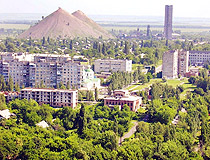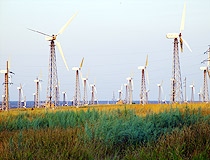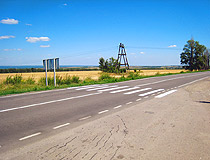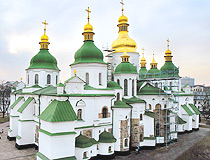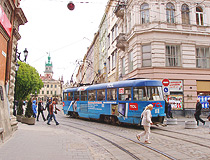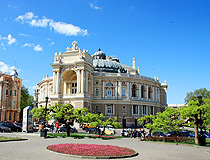Ukrainian Economy - Overview
In 2016, according to The International Monetary Fund, the economy of Ukraine was on the 50th place in the world in terms of GDP (Gross Domestic Product) at PPP (Purchasing Power Parity) - $ 353 billion. The economy of the country is based on a multi-sectoral industry, agriculture, and services. In 2016 and 2017, Ukraine’s economy grew by about 2% every year after several years of strong decline.
Ukraine is a potentially rich country that realizes itself and is perceived from the outside as a political and economic power similar to Poland and Turkey. Among the former republics of the USSR, Ukraine inherited one of the best sets of initial resources. Before independence, the economy of the Ukrainian SSR was playing a significant role in the economy of the USSR.
The most economically developed regions of Ukraine are Donbass (the Donetsk and Luhansk regions), the Dnieper River area (the Dnipropetrovsk and Zaporozhye regions), as well as the cities of Kyiv, Kharkiv, Odessa, Lviv.
Agriculture of Ukraine
Favorable climatic conditions and soils of Ukraine provide relatively high yields. In 2011-2012, Ukraine accounted for 2.6% of world cereal production and 9.2% of world grain trade, which allowed the country to take the 6th place among the countries that export grain.
In 2012, the grain harvest amounted to 46 million tons, in 2013 - 63 million tons. In 2014, Ukraine, excluding the Crimea, harvested 63.8 million tons of grain and legumes, which became a record since independence.
In 2015, Ukraine, excluding the Crimea, Sevastopol and parts of the Donetsk and Luhansk regions, collected 60.1 million tons of grain and legumes, sugar beet - 10.3 million tons, potatoes - 20.8 million tons, sunflower seeds - 11.2 million tons. The sown area of agricultural crops in farms of all categories for the harvest of 2015 was 26.7 million hectares, which is 540 thousand ha less than in 2014.
Fuel and Energy Complex of Ukraine
The fuel and energy complex of Ukraine only partially meets the country’s needs. Ukraine has significant reserves of hard coal (the Donetsk and Volyn basins) and brown coal (the Dnieper basin); small oil and natural gas deposits are located in the Carpathian region and in the north-east of the country.
These energy resources are used at large thermal power plants. There is a cascade of hydroelectric power stations built on the Dnieper River. More than 45% of electricity in Ukraine is provided by nuclear power plants (Zaporozhye, South-Ukrainian, Khmelnytskyi, Rivne). All Ukrainian nuclear power plants were built in Soviet times. The Chernobyl Nuclear Power Plant was finally decommissioned on December 15, 2000.
Ukraine is an exporter of electricity. Its main customers are Hungary, Poland, Slovakia, Romania, and Moldova. In recent years, Ukraine is actively developing alternative energy.
Ukraine - a great place for agriculture
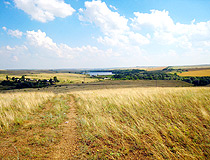
Hilly relief of the Lugansk region
Author: Alexander Byelkin
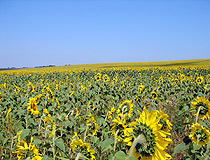
Sunflower field in the Cherkasy region
Author: Dmitriy Tkachuk
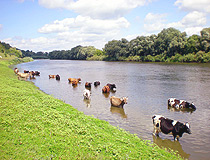
Cows in the Chernihiv region
Author: Herve Mercier
Industry of Ukraine
Ukraine belongs to the countries with developed industrial potential. The leading industries are ferrous metallurgy and machine building, although their share is changing with time. From 1990 to 2008, the share of machine building in the structure of Ukraine’s industrial production changed from 31 to 14%, ferrous metallurgy - from 11 to 27%. The production of ferrous metallurgy accounts for almost half of the exports of heavy industry.
The chemical industry operates in a single complex with metallurgy, using by-products of metallurgy and coke industry for the production of nitrogen fertilizers, varnishes, paints, and medicines. Phosphorites, potassium salts and table salt are used for the production of mineral fertilizers, sulfur - for the production of sulfuric acid. Oil and natural gas - both local and imported - are used to produce synthetic rubber and synthetic fibers.
Machine building is mainly represented by heavy, transportation, electrical engineering, production of aircraft, ships, military and space equipment, precision equipment. Ukraine exports auto components, jet engines, railway locomotives and wagons, turbines, pumps and spare parts for them, electrical equipment.
The main sub-sectors of light industry are the textile industry, the garment industry, the leather and fur industries. Enterprises of the food industry are located everywhere.
The main massifs of forests are concentrated in the Carpathians and Polesie - about 90% of all logging operations of the Ukrainian timber industry are carried out there.
Transportation of Ukraine
The total length of paved roads in Ukraine is about 115,000 km, railways - about 23,000 km; the total length of the river shipping routes - 4,500 km. Also there are several large seaports and an extensive network of pipelines used to transport natural gas, oil, oil products, and ammonia.
Railway transport is of great importance for the economy of Ukraine. It accounts for about 80% of freight turnover (excluding pipelines) and almost 40% of passenger turnover. In 2016, the turnover of all ports amounted to 131.7 million tons. The largest ports are Yuzhne, Odessa, Chornomorsk, Mykolaiv, Kherson, Mariupol. The Dnieper and Danube rivers are important ways of transporting international cargo.
There are international airports in Kyiv, Kharkiv, Dnipro, Zaporozhye, Lviv, and Odessa. Boryspil International Airport located near Kyiv is the largest airport in the country.
Tourism, Trade, and Living Standards in Ukraine
Ukraine has a rich tourism potential: the Carpathian Mountains, historical monuments of old Ukrainian cities, rural (green) tourism, and nature reserves. There are several UNESCO World Heritage Sites in the country: St. Sophia Cathedral and Kyiv-Pechersk Lavra in Kyiv, the historic center of Lviv, virgin beech forests of the Carpathians, the residence of the Bukovinian metropolitans in Chernivtsi.
The main partners in Ukraine’s foreign trade are Russia, Turkey, China, Egypt, the EU countries, Belarus, Kazakhstan. The main partners of Ukraine in the EU are Poland, Italy, Germany, Spain, the Netherlands, and Hungary. Ukraine occupies the 8th place in the export of agricultural products to the European Union.
In 2015, the main export goods were the products of agriculture (31.1%), metallurgy (24.8%), machine building (12.1%), raw minerals (8.1%), food products (6.5%), chemical products (5.6%), timber and wood products (2.9%).
In 2016, about 16 million Ukrainians were officially employed. In 2017, the average monthly salary was at the level of about $ 300 per month. In the spring of 2013, Ukraine ranked fourth in the world in terms of the number of certified IT specialists after the United States, India, and Russia.





